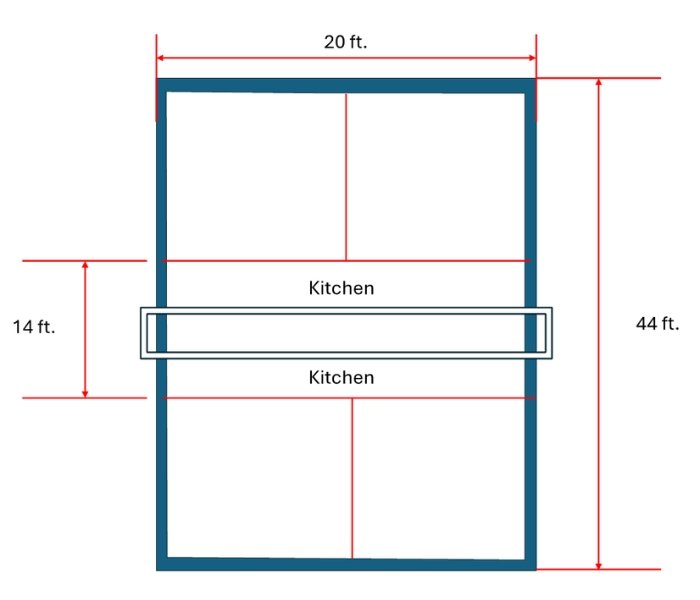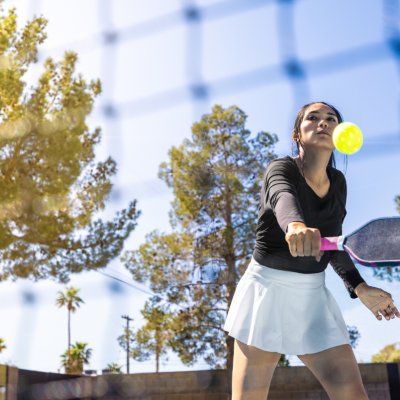Pickleball is the fastest growing sport in America with participation up 171% in 2023 according to a report by the Sports and Fitness Industry Association. Both the cost and physical barriers to entry are low. With increased participation comes increased injuries and physical therapists need to understand the game and associated injuries.
Pickleball in Brief
Pickleball is played on a 20 ft x 44 ft court with a net in the center and a “kitchen” (area in which you may not volley a ball in mid-air) that extends 7 feet on each side of the net (see Figure). Players use paddles and a hard plastic ball with holes in it, and in conventional scoring (there is rally scoring), a player (singles) or a team (doubles) can only score while serving and the serving motion is underhand (you may not strike the ball above the waist on a serve). In conventional scoring, the game is to 11 points and the winner must win by 2 points.
Figure. Pickleball Court

Pickleball Strategy
Players gravitate toward a style of play that makes them most comfortable, and no player plays only one style of play (if they want to win) but largely there are players who favor a slower game designed to minimize errors and take advantage of opponents’ mistakes and those who favor a more aggressive approach designed to force your opponents into errors and hit unreturnable shots. The game has changed these last few years to one that favors a more aggressive style (thus the increase of players wearing protective eyewear) but a solid strategy remains to hit a short ball that lands in the kitchen (remember, in this area an opposing player may NOT hit the ball out of the air/volley it) and then advance to the area just outside the kitchen and dominate the net.
Benefits of Pickleball
Singles pickleball has cardiovascular benefits, the typical singles match lasting 30-60 minutes and repeated short sprints and lateral movement. Doubles pickleball likely has fewer cardiovascular benefits but whether one plays singles or doubles, the benefits are numerous. First and foremost, there is the community of pickleball players who are largely kind and welcoming of new players to the sport and players from other areas of the country who drop by the local courts looking for a game. Next there is the agility and footwork required to be a competent pickleball player. Finally, there is the competition and strategy required to best the competition.
Associated Injuries
In my experience, the injuries fall into 2 categories based on age. Older players are prone to traumatic injuries like hip fracture, wrist fracture, Achilles tendon strain/tear, and concussion. Younger players that I treat get pickleball elbow (wrist extensor tendinopathy), hip issues like impingement and torn labrum, calf strains, and low back pain. Shoulder injuries are not as common as they are in tennis, likely due to the fact the pickleball serve and many of the shots are executed with the shoulder below 90° of elevation.
Treatment of Injuries
For traumatic injuries, the primary care physical therapist should have a high level of suspicion in an older athlete with traumatic onset and refer the player appropriately. For non-traumatic injuries, prevention is the best medicine. Strength and agility training are important before playing pickleball as it requires a change of direction both laterally and forward/backward. Like in other sports where the injury is prevalent, extensor tendinopathy can be the result of equipment mismatch (paddle handle too large or small), technique (stroke fundamentals, grip pressure), overuse (load is too great) or some combination of these factors. Addressing these factors with coaching, load mitigation, and strengthening are important. Hip issues like impingement can be managed with manual therapy and strengthening exercise and if a torn labrum is suspected, referral for imaging so that if a torn labrum is confirmed, the patient has the option of surgical intervention. For calf strains, which largely happen as either the player steps back and plants the leg or has to sprint forward from a standstill, eccentric strengthening and also plyometric training to improve the stiffness (ability to absorb and return force) of the musculotendinous unit. Finally, in my experience, the low back pain I have treated is largely mechanical from either overuse or due to the rapid, eccentric motion required to return shots aimed at the feet by opponents. Treatments should include awareness of days/hours of play and practice and eccentric strengthening.
Summary
Pickleball is the fastest growing sport in America and with its increased popularity have come increased injuries. Physical therapists will absolutely see injured pickleball players in their practice and should be aware of the demands of the game and the injuries those demands tend to produce.
Key Words: pickleball, tendinopathy, hip pain
The author declares no competing interests.
Author Bio
Eric J Hegedus, PT, DPT, PhD, MHSc is the Founding Department Chair for Rehabilitation Sciences at Tufts University in the School of Medicine. He previously was Founding Program Director for the Tufts University Doctor of Physical Therapy Programs in Phoenix, AZ and Atlanta, GA as well as the founding Department Chair for High Point University’s Department of Physical Therapy and a Vice-Chief for Duke’s Doctor of Physical Therapy program. Dr. Hegedus has had a notable 32-year career as a leader and innovator in physical therapist education, research, and clinical practice. He is an ABPTS-certified Orthopedic Physical Therapy Specialist, with continued clinical practice working predominantly with athletes. Dr. Hegedus has won several awards and honors as a teacher including the James A Gould Excellence in Teaching Orthopaedic Physical Therapy award. He is an international speaker with over 95 published peer-reviewed manuscripts.
He currently is an avid pickleball player.

